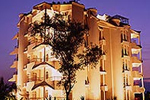Bhubaneswar - Temple City of India
The capital city of Orissa, Bhubaneswar -- earlier known as Toshali and Nagar Kalinga – is the temple city of India. It presently boasts of more than 600 temples, including the world famous temples of Lingaraj and Mukteswara. It is said that at one time it has as many as 7000 temples. The largest city of Orissa, Bhubaneswar is an ancient city with a history that dates back to 2000 years.
The first recorded history of the place goes back to the second century BC when the Chedi dynasty ruled and they had their capital at Sisupalgarh, near the present-day Bhubaneswar. An important part of the famed 'Golden Triangle' -- one of the most visited destinations of the Eastern India; Bhubaneswar has been one of the most visited tourist places in India, and Orissa in particular, since the early medieval days.
Modern Bhubaneswar is a hub of sorts of economic and religious value in the area. Designed beautifully by the German architect Otto Konigsberger in 1946, Bhubaneswar is one of the first planned cities of today -- much like Jamshedpur and Chandigarh
Attractions
The enchanting destination of Bhubaneswar has several attractions -- most of which happen to be religious and cultural spots. However, this temple city of India has more to offer to the discerning travelers, in the process, making the place an incredible spot from the tourism viewpoint.
Parasurameswara Temple: This gem of a temple built during the seventh century marks the most effusive elements of the exclusive Orissa style of temple architecture. A somewhat small shrine, it features the traditional deul (beehive shaped tower) and the jagmohun (porch) -- two important characteristics of the Orissa style.
Mukteswara Temple: The temple built in 950 AD is said to mark the period of architectural changes in the Kalinga School. The entrance to the sanctum has the nine planets in place of the earlier eight. Fine sculpted detailing at the gateway to this amazing temple catch the visitors attention.
Vaital Deul: Built along completely different lines from the Parasurameswara and Mukteswara Temples, this 800 AD temple belongs to a subdivision of the Kalinga School, the Khakara style, which was employed in the tantric temples.
Lingaraj Temple: Perhaps the most famous temple of the region, the Lingaraj Temple was built during the 11th century and it signals the most mature aspects of architectural progress. It is thronged by an impressive number of devotees daily.
Nearby Attractions
Dhauli: Located eight km away from Bhubaneshwar, the Buddhist site of Dhauli is the place where the famed bloodshed of Kalinga took place following which the Emperor Ashoka switched over to Buddhism. The inscriptions on the rock cut edict at Dhauli that dates back to 260 BC is the first historically recorded piece of proof of Ashoka's famed adoption of a non-violence way of life.
Khandagiri and Udayagiri: Situated six km away from Bhuvaneshwar, Khandagiri and Udayagiri are the twin rock-cut caves built by King Kharavela -- a vociferous supporter of the Jainism. Significantly, these cave monasteries for the Jain monks, marked by a lively folk element in the elaborate carvings, are still well preserved.
Nandankanan: This lovely biological park situated 20 kms from Bhubaneshwar is the habitat of the very first captive gharial breeding centre of India. However, it is the White tigers which are really the USP of the Nandakanan zoo.
Pipli: Known For It Famous appliqué works. This Village Boast Of some world Famous craftsmen and is a colorful open emporium for the visitors.
Where to Stay
There are several Bhubaneshwar hotels suiting almost all budgets where one can stay while on a visit to this place. Some Of The important ones are Swosti Premium, Mayfair Lagoon, HHI, Crown,Presidency Etc.








